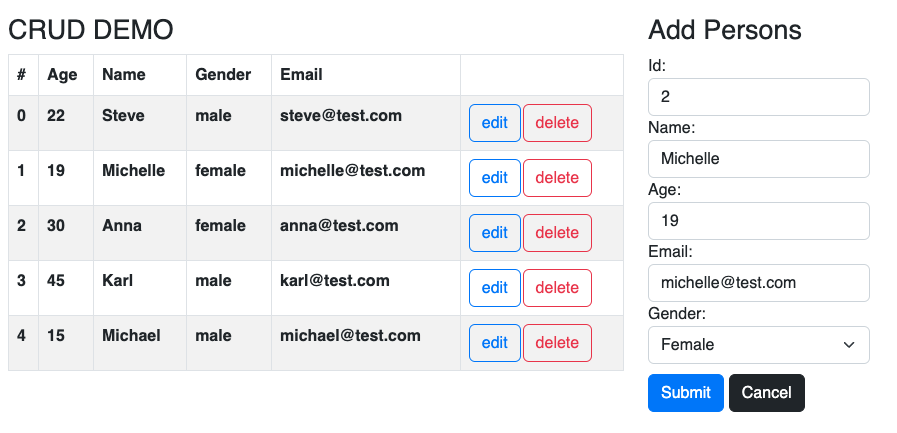React CRUD & Form
This is a guided tutorial in which we will:
-
Fetch person data from an api (JSON Server)
-
Show a list of persons
-
Implement simple
CRUDoperations on the persons. This includesGET,POST,PUT, andDELETEhttp requests by using Javascripts’fetchmethod. -
Do a little styling with css
We aim for something like this mockup:

The video series
Code happily along with the video tutorials - and use the snippets from this file when needed. In this way we can speed up the work a bit. The videos are called: forms_01 to forms_05.
- Get started (16:23)
- Create components (8:05)
- Get all persons (16:28)
- Delete (20:28)
- Create and update (49:36)
These are the steps:
1. Getting the project configured
- Create a React project with Vite
- Cleaning up stuff
2. Using JSON server
- Configuring the JSON server. Copy this json snippet and insert into a
db.jsonfile.
{
"api":
[
{
"id": 1,
"age": "22",
"name": "Steve",
"email": "steve@test.com",
"gender": "male"
},
{
"id": 2,
"age": "19",
"name": "Michelle",
"email": "michelle@test.com",
"gender": "female"
},
{
"id": 3,
"age": "30",
"name": "Anna",
"email": "anna@test.com",
"gender": "female"
},
{
"id": 4,
"age": "45",
"name": "Karl",
"email": "karl@test.com",
"gender": "male"
},
{
"id": 5,
"age": "15",
"name": "Michael",
"email": "michael@test.com",
"gender": "male"
}
]
}
A snippet for the package.json:
"jsonserver": "json-server --watch data/db.json --port 3000 --host 127.0.0.1"
Add the json server port to vite.config.js like this:
import { defineConfig } from 'vite'
import react from '@vitejs/plugin-react'
// https://vitejs.dev/config/
export default defineConfig({
plugins: [react()],
server: {
proxy: {
'/api': 'http://127.0.0.1:3000'
}
}
})
Also, install the VS Code extention REST Client af Huachao Mao. This makes it possible to create a dev.http file to test out the api as we do it in IntelliJ.
This is a suggestion for a dev.http file for testing:
GET http://localhost:3000/api
###
GET http://localhost:3000/api/2
###
POST http://localhost:3000/api
Content-Type: application/json
Accept: application/application/json
{
"age": "22",
"name": "Steve",
"email": "steve@test.com",
"gender": "male"
}
###
PUT http://localhost:3000/api/2
Content-Type: application/json
Accept: application/json
{
"age": "22",
"name": "Steve",
"email": "steve@gmail.com",
"gender": "male"
}
###
DELETE http://localhost:3000/api/6
Accept: application/json
3. Creating components
- PersonForm.jsx
<form>
<label htmlFor="id">Id</label>
<input name="id" id="1" type="number" readOnly placeholder="id" />
<label htmlFor="name">Name</label>
<input name="name" id="name" type="text" placeholder="name" />
<label htmlFor="age">Age</label>
<input name="age" id="age" type="number" min="1" max="120" placeholder="age" />
<label htmlFor="email">Email</label>
<input name="email" id="email" type="email" placeholder="email" />
<label htmlFor="gender">Gender</label>
<select name="gender" id="gender">
<option defaultChecked>Select Gender</option>
<option value="male">Male</option>
<option value="female">Female</option>
<option value="other">Other</option>
</select>
<button type="submit">Submit</button>
</form>
- PersonList.jsx
<table className="table table-striped">
<thead>
<tr>
<th>Id</th>
<th>Name</th>
<th>Age</th>
<th>Email</th>
<th>Gender</th>
<th>Action</th>
</tr>
</thead>
<tbody>
<tr>
<td>1</td>
<td>Bingo</td>
<td>34</td>
<td>bingo@gmail.com</td>
<td>Malicious</td>
<td>
<button>Edit</button>
<button>Delete</button>
</td>
</tr>
</tbody>
</table>
4. Setting up states
5. Fetching persons from the JSON-server
Create a new folder util and a file persistence.js:
export function fetchData(url, callback, method, body) {
const headers =
{
'Accept': 'application/json'
}
if (method === 'POST' || method === 'PUT') {
headers['Content-Type'] = 'application/json'
}
const options = {
method,
headers
}
if (body) {
options.body = JSON.stringify(body);
}
fetch(url, options)
.then(res => res.json())
.then(data => callback(data))
.catch(err => {
if (err.status) {
err.fullError.then(e => console.log(e.detail))
} else {
console.log("Network error");
}
})
}
6. Showing the persons
7. Inserting new persons
const handleSubmit = (evt) => {
evt.preventDefault();
const formPerson = new FormData(evt.target);
const person = Object.fromEntries(formPerson.entries());
console.log(person);
// fetch with POST
}
8. Editing persons
9. Deleting persons
10. Styling with html and css
- Make it look smashing ;-)